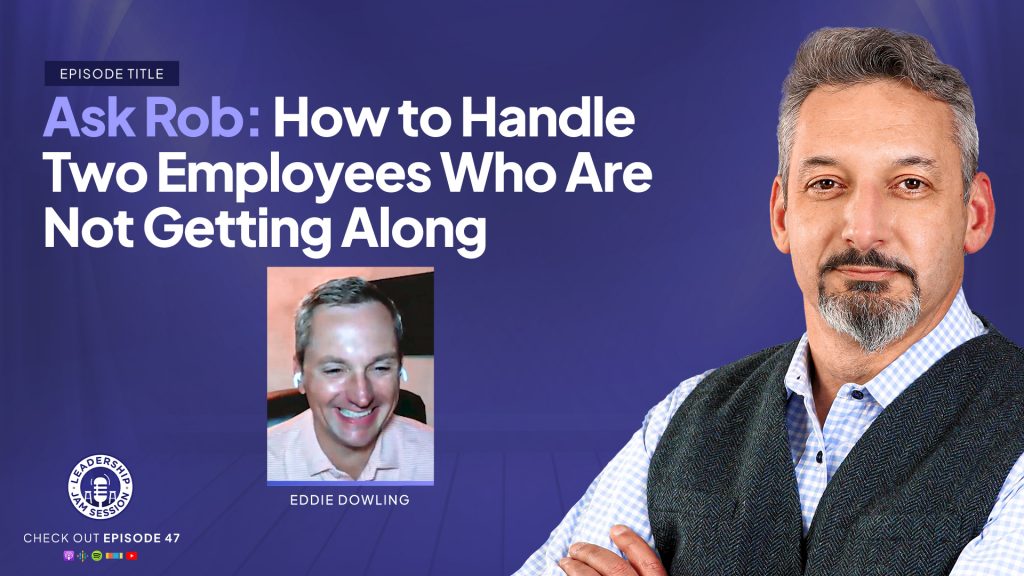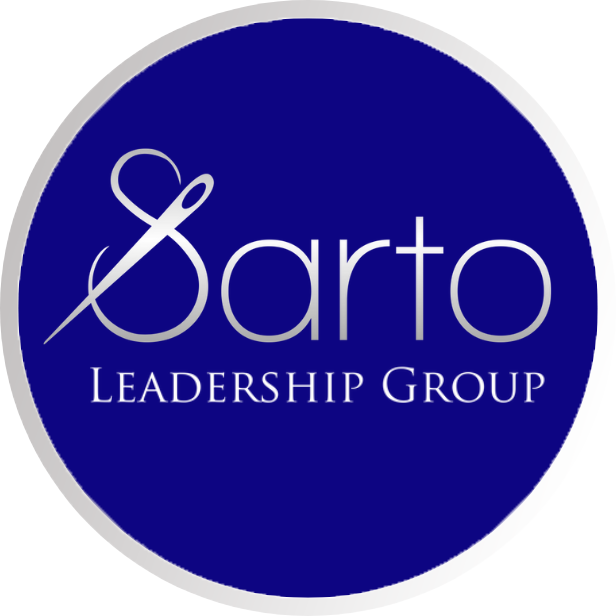047 – Ask Rob: How to Handle Two Employees Who Are Not Getting Along

Today’s episode will feature a new format we’re launching called ‘Ask Rob’, where I answer questions I’ve received from listeners on how to handle challenging scenarios related to managing teams.
This episode is based on a question I recently received asking me how to manage two employees who are not getting along but need to work together to achieve a common goal.
To help me tackle this specific, challenging scenario, I brought in Eddie Dowling, a seasoned leader and a dear friend of mine who’s also been on the Leadership Jam Session podcast before.
We’ll discuss why it’s essential to take a step back and understand the context of the conflict and that it didn’t happen overnight. And we’ll also talk about why it’s in your employee’s best interest to get them to work it out themselves.
How to handle two employees who are not getting along
First of all, let’s take a look at the question we’ll be answering today, sent by Jill (We won’t be disclosing the sender’s actual name to protect their privacy) :
“I have two employees on my team who are not getting along. To achieve their results, they need to partner closer together and work more collaboratively. They both come to me to complain about each other and how difficult it is to work with one another. So if you were in my shoes, how would you handle this situation?”
Establishing the context of the issue and how it came to be will help you determine which approach you should be taking, and in most cases, solving conflict between two employees all boils down to a couple of options.
The first option is to push the issue in question back to your employees. Sometimes, it’s in all parties’ best interest to avoid escalating the situation by drawing you in.
Of course, this doesn’t mean you shouldn’t be coaching them individually on finding a solution to this problem. You should act behind the scenes, providing guidance on how they need to work the issue out and what kind of discussions they should be having.
And the best way to approach these meetings is to help your employees find that shared purpose both of them have and allow them to figure out a way to turn the conflict into a win-win situation.
If this approach doesn’t work, you’ll have to go for the second option, where you’re going to have to sit down with both of them and have a straightforward conversation.
There, you’ll make clear that not everyone might walk away happy from that meeting if they don’t resolve the conflict and you do happen to get involved.
Why perspective is essential
During these meetings, asking questions like “What’s the value your partner brings to you?” or “How do they make you better?” can go a long way; sometimes, a slight shift in perspective is all that is needed!
You also want your employees to understand that you do expect diversity in terms of thoughts and ideas as a leader.
Diverse thinking within a team is vital for developing innovative ideas and different ways to approach things. And as a leader, you need to be there along the way, reinforcing that and providing guidance.
This is why you should encourage healthy debate among your team – of course, while doing that with respect and a willingness to learn from each other.
The secret here is to balance having a diversity of ideas with setting a common goal everyone agrees with.
The 4 strategies to adopt when dealing with employee conflict
1.Set your expectations early on
The sooner you let your team know that you expect disagreements to happen, the better. If you communicate the idea of healthy debate and reinforce it throughout your time with your team, conflicts will happen less frequently and will be resolved faster.
We’re not going to all approach things the same way. But that is okay; in fact, it’s something that you should be looking for in a team.
2.Determine your role in the situation
There may be some cases in which a problem between two employees stems from reasons related to you. Perhaps you contributed to the issue by not setting proper expectations, caused some confusion, or you’re somehow viewed as favoring one employee versus the other.
The point is that there could be a variety of reasons for you to be the root cause of a conflict between two employees, and in that case, it’s critical to own your part in the solution process.
3.Understand where the problem is coming from
The first step to solve a conflict is to understand its origin. As mentioned earlier, this is why it’s crucial to have a clear context and history of the problem.
Your job as a leader is to expand on the problem so your employees can get to the root and determine who owns what piece of it.
And sometimes it’s helpful to ask your employees whether they want to be perceived as the problem or the solution and how they would improve the situation.
4.Why timing is key
You need to remember that this issue going on between your two employees didn’t happen overnight in most cases. And therefore, the resolution behind it isn’t going to happen overnight, either.
As we’ve discussed previously, you jumping into fixing the problem right out of the gate may not be the best solution. Your job is to be there along that journey, serving as a guard rail and providing your insights.
If you have a challenging scenario that you’d like to get my thoughts on, please go to my website at leadershipjamsession.com and look for the ‘Ask Rob’ logo.
There, you’ll find out more about how you can submit your challenging scenario to me – which could get featured right here on the jam session.
Key Takeaways
– Episode intro (00:00)
– How to handle two employees who are not getting along (01:27)
– Trying to find a shared purpose (02:43)
– Why it’s important to expect and encourage healthy debate (06:03)
– Why a leader’s role is to be a guardrail for the team (08:08)
– Assessing your role in the conflict (13:35)
– Episode recap (15:26)
Leadership Resources
How are the leaders at all levels of management tackling the toughest challenges each day? Learn more at: https://sartoleadershipgroup.com

